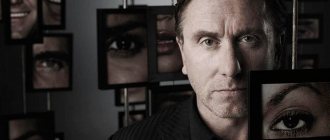Lying is an element of communication that all people use: some often, some very rarely. Sometimes the use of deception occurs completely consciously, for selfish purposes. It also happens that a liar does not realize that he is giving out false information. In both cases, there are ways that help you understand that a person is deceiving. It is revealed by lying gestures, special facial expressions, logical errors and slips of the tongue.
If you would like to listen to a recording of this article, you can use the player below:
Types of lies
A lie is any false information communicated by one person to another. Often people lie completely in vain. They distort the truth, try to embellish it, or suppress important details. Although there is no need to lie.
Depending on the goals pursued by the “liar,” the following types of lies can be defined:
- Unconscious. Being under the influence of strong emotions, a person does not realize that he has embellished part of the story with unreliable facts. Very often, young children lie unknowingly simply because they are not yet able to remember a large amount of information and resort to the help of their wild imagination.
- Deliberate. In this case, the person is well aware that he is lying in pursuit of his goal. Deliberate lies are not always used to achieve any selfish goals. It happens that people deliberately hide the truth, wanting to protect their loved ones. This is the so-called white lie. When, for example, someone hides their serious illness from relatives so as not to cause them suffering.
- Active. This is a type of deliberate lie that does not have a clear purpose. A person simply invents events that did not actually happen to him. Most often, this is done in a conversation with unfamiliar people in order to seem like a more interesting and intelligent interlocutor.
- Passive. Such lies manifest themselves in the suppression of facts. For example, a man who has been in a relationship with a woman for a relatively short time is in no hurry to tell her that he is married and has children.
- Pathological. This type of lie is characteristic of people with low social status. They invent a whole life for themselves in which they occupy a high position or have a noble origin. At the same time, the liar himself sincerely believes in it.
The most common reason for lying is fear. A person who deceives others, but does it unprofessionally, can be easily recognized by his facial expressions and gestures, and by his eyes. They will signal that he is scared.
Analysis of verbal responses
Voice.
Changes in voice speed and tone can be good indicators of deception. The same evidence may be hesitation before answering or sudden stuttering or long pauses.
Excessive talkativeness.
A reason to doubt a person’s sincerity may be the fact of his answers to seemingly simple questions that require a direct and short answer. Instead, the liar begins to clarify unnecessary details and at the same time often seeks support from your agreement with his words.
Emotional reaction.
Monitor your interlocutor's behavior throughout the conversation. A truthful person, who has nothing to hide, reacts differently than a liar, whose reaction ranges spectrally from feigned nonchalance to aggressively indignant.
Examination.
In films, we quite often see how experienced investigators, with their questions, catch liars in discrepancies. Indeed, to verify truthfulness, you can remember the answers to some questions and ask the same questions over time and compare the words. Untruthful people often get confused, break off sentences in the middle, and laugh off awkward questions. At the same time, the frequent use of the same “rehearsed” mechanical answers most likely indicates the falsity of the data.
Don't fall for the tricks.
Often, when a person wants to hide his true motives, he resorts to a set of long-invented tricks. Frequent compliments, abrupt transitions from topic to topic after uncomfortable questions, distraction of attention to unimportant details can be an additional reason to doubt a person’s sincerity.
Who knows how to recognize a lie?
Astrologers say that among all the zodiac signs, Cancers are the best at recognizing lies. Why? The fact is that they feel the mood very subtly and understand the motivation of other people. In other words, Cancers have highly developed intuition. They sense deception without having any special knowledge of how to recognize lies.
Recently, the profession of a profiler has become very popular. A profiler is a person who recognizes lies by facial expressions, gestures, and demeanor of the speaker. People of this profession are in demand during business negotiations, issuing bank loans, when interviewing future employees, etc.
Their training system is based mainly on the works of such famous psychologists as Alan Pease and Paul Ekman, who for many years studied the mechanisms of lies and developed methods for detecting them. Based on their books, the popular series “Lie to Me” was filmed, the main character of which is an expert in detecting lies.
Some of Alan Pease's books, written with his wife Barbara:
- “Body language.”
- “The language of relationships.”
- “New body language.”
Paul Ekman's most popular books on detecting lies:
- Psychology of lies.
- Recognize a liar by his facial expression.
- Psychology of emotions.
These are quite extensive works. If you are seriously interested in such an activity as detecting lies, then I advise you to read them. In this article, I will tell you how you can identify a liar based on the most obvious signs.
Did you wash your hands?
If, when communicating with you, the interlocutor tries to put his hands in his pocket or close his palms, we can with a certain degree of confidence assume that he is hiding something. This feature is most pronounced in children.
Hiding your palms or keeping them open can be used against you even in a regular market. An experienced salesperson can see how your palms are positioned when you refuse a purchase and can understand how much you really need it. If you cover your mouth with your hand, then here we see a desire not to blurt out too much. This may be indicated by tension in the mouth muscles, as well as lip biting.
Posture is very important in determining a person's honesty. Let's say you observe a person in a tense or uncomfortable position. He can constantly squirm, trying to make himself more comfortable. This means that the topic of conversation is bothering him and he may not agree with it. Liars can lean and cross their legs. Usually, if a person is truthful, then his posture is relaxed and comfortable.
How to spot a lie
If you are not Cancer by zodiac sign, do not have very developed intuition and do not master the art of profiling, then carefully observe the interlocutor to recognize deception. An unprofessional liar will definitely give himself away. Especially if it is a Virgo woman. According to astrologers, they are the ones who absolutely cannot lie.
By facial expressions
During a conversation, look at the interlocutor and watch his facial expression. Scientists have found that a person's facial expression usually changes every 10 seconds. If the change of emotions on the speaker’s face occurs more often, then most likely he is lying.
Another important sign of deception is a discrepancy between a person’s words and emotions. For example, the interlocutor told you that he was sad, but his facial expression did not change and remained calm. Or he belatedly showed sadness on his face. For someone who speaks the truth, emotions and words will always coincide and appear synchronously.
Also, a liar may have an unnatural smile on his face, more like a wax mask. At the same time, the speaker stretches his lips too much, moving the lower jaw a little back.
By gestures
Unlike facial expressions, human gestures literally catch the eye. The main signs of lying are:
- excessive gesticulation if the person you’re talking to doesn’t usually behave that way;
- complete absence of gestures;
- the use of theatrical, feigned gestures.
Touching your eyes during a conversation can also be taken as a sign that they are trying to deceive you. At the same time, girls seem to correct their makeup by running their fingers under their eyes, and men rub their eyelids. Thus, the interlocutor avoids eye contact. However, this gesture can indicate not only a lie, but also simple fatigue.
Wanting to hide the truth, many people begin to touch their ears or scratch their neck. Moreover, this gesture is repeated quite often - more than five times during the conversation. Many people, when they lie, are very worried and worried. Their pulse quickens, they feel hot, and they sweat a lot. To cool themselves down at least a little, liars pull back or unbutton the collar of their shirt or sweater.
However, if a person is angry or upset about something, he will also use this gesture. To avoid making hasty conclusions, simply ask your interlocutor again. The person who is lying to you will most likely hesitate and remain silent for a while.
By phone
It is quite difficult to recognize deception in a telephone conversation, because you can only monitor the rate of speech, intonation, and volume of the voice. In addition, the connection quality may not be the best. Therefore, if you doubt what you hear, simply ask again, ask clarifying questions to catch the liar in his own contradictions and inconsistencies. Or ask for a personal meeting to personally observe the facial expressions and gestures of your interlocutor.
An indirect sign of lying during a telephone conversation may be coughing or clearing your throat. A person who tells a lie feels very tense, begins to sweat, and as a result his throat becomes dry. But this will not necessarily indicate deception.
Correspondence
It is even more difficult to detect lies in correspondence on social networks. After all, you don’t see or hear your interlocutor. The only thing that can be analyzed in an attempt to detect deception is text messages.
You can suspect that your interlocutor is lying to you if he:
- started writing too long sentences, cluttered with unnecessary facts;
- unexpectedly began to place punctuation marks and capital letters, although this had not been noticed before;
- Instead of short and clear messages, I began to write detailed and long comments.
A liar's change in writing style occurs unconsciously. In this way, he tries to convince himself that he is not lying, but is just making things up. At the same time, he is so carried away that when talking about some event, he describes it in the smallest detail. But most often we cannot tell in detail what we did yesterday.
The truth is somewhere on the left
A person may be overtly or covertly tense. To determine this, look carefully at the person’s left side. From a neurophysiological point of view, control over the left half is less strong than over the right. The brain, with its left and right hemispheres, controls the sides of the body differently.
- Speech, intelligence, and the ability to do mathematics are the domain of the left hemisphere.
- Imagination, emotions, abstract thinking are the work of the right hemisphere.
- Management occurs generally in the form of crossing. The left hemisphere is the right side of the body, and the right hemisphere is the left side.
For example, we communicate with a right-handed person. During the conversation, he gesticulates vigorously, using his left hand. It is very likely that this is a liar. This is most pronounced if the right hand is almost not involved in the matter. If such a discrepancy is observed, the person is definitely not sincere. If the same disorder is observed in the face, i.e. the left or right half is more active, perhaps also a lie. Particular attention should be paid to the left side.
Lack of facial expressions
If there is no facial expression, then the person is either not himself, or is trying to hide his emotions. After all, such self-control in the case of openness does not make sense, so people with a straight face should be treated with the utmost care.
Now you know how to understand that a person is lying. Do not forget that all people are different, facial expressions of deception can manifest themselves differently each time. For some, some signs of lying will clearly prevail, for others, others will prevail. But the most important thing is to evaluate the information as a whole, otherwise you can notice an emotion in a person, but misinterpret it. And don’t think that everything is very complicated, it’s not. Moreover, it is very interesting and even funny. Therefore, practice more, observe, and many secrets of your interlocutors will be revealed to you.
Loading …
Three signs that feelings are being faked
Asymmetry of facial expression
If one side of the face is more contorted than the other, this is a sign of false emotion. During far-fetched experiences, the muscles that cause a smile on one side of the face will contract more strongly.
Duration
Facial expressions that last 5-10 seconds are usually fake. Most genuine emotions only appear on the face for a few seconds. Otherwise they will look like a mockery.
Untimeliness
A sincere person's words, gestures and facial expressions are synchronized. If someone shouts: “I’m so tired of you!”, and an angry facial expression appears only after the remark, the anger is most likely fake.










